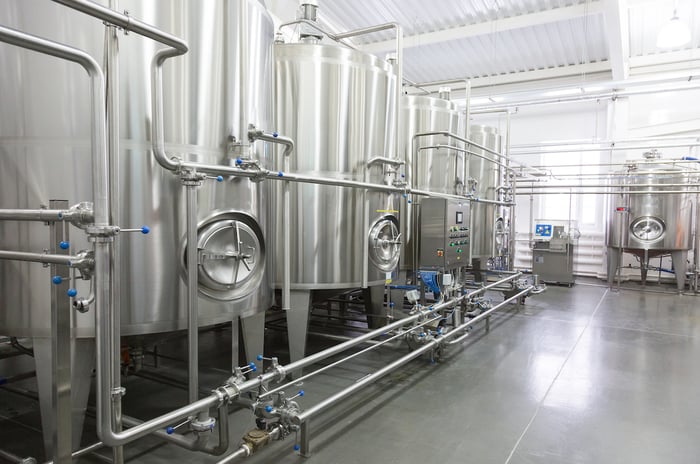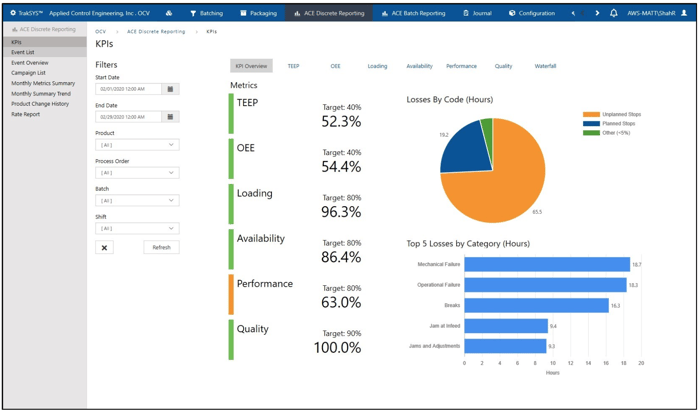Implementing an Enterprise-Wide MES
The Challenge:
Identifying and evaluating lost production opportunities and determining avenues for improvement throughout the manufacturing facilities of a global Fortune 500 company producing a wide variety of products.

The Solution
This organization worked with Applied Control Engineering, Inc. (ACE), to implement a manufacturing execution system (MES) that uses Parsec’s TrakSYS software to track overall equipment effectiveness (OEE) to identify production bottlenecks that could be improved upon.
When a multi-billion-dollar company has manufacturing operations spread throughout more than 120 facilities around the world and is producing a wide variety of products, it can be difficult to ensure every facility is operating near peak performance. This is exactly the position one global manufacturer recently found themselves in after undergoing several mergers.
Many of their manufacturing facilities were not properly instrumented to track productivity metrics, and those that were did not use common standards. This led to a situation where management could not determine operational issues or know what the extent of any issues were. However, based on anecdotal evidence and what they could see happening on their plant floors, they felt confident there were efficiency gains to be made that could save millions of dollars.
To improve their overall manufacturing processes, this organization’s management team set out to formulate a plan that targeted several aspects in which data is managed and consumed. First, they wanted to develop a standard method for viewing performance metrics across all factories, including those that were recently acquired. Second, they wanted to identify potential bottlenecks at each facility that were preventing them from getting as much out of their manufacturing infrastructure as they should and improve on those issues. Third, they wanted to remove the disconnect that existed between their operations and supply chain by improving the availability of real-time production data.
To make these improvements, the management team knew it needed to implement a system that could identify issues and inefficiencies, compare plants producing similar products, provide real-time access to production data, and allow engineers and management to look back at manufacturing operations over time. In short, they knew they could not fix anything if they were not measuring anything. Thus, their next step was to develop a plan to implement a proper manufacturing execution systems (MES).
Implementing MES to Measure Overall Equipment Effectiveness
This company spent nearly two years evaluating different MES solutions and software. Since improving productivity was their main goal, the organization’s leadership agreed that the new solution needed to be able to analyze OEE across all their manufacturing facilities.
To calculate OEE, three data points need to be measured—equipment uptime (availability), equipment efficiency while it is up and running (performance), and the amount of good product produced (quality). They selected Parsec’s TrakSYS software as their OEE tool because of its extensive capabilities as an MES for discrete systems, packaging lines, continuous processes, and batch applications. The software also exceeded their requirements for providing performance analysis across all their facilities and has additional modules they can add as needed including journaling, historian, alerts, and scheduling.
A phased multi-year implementation was planned for deployment of the OEE systems at their global manufacturing sites. Since each plant is different, they could not have someone develop a one-size-fits-all solution. As a result, the company wanted to find well-qualified integrators experienced in working with TrakSYS to develop solutions for each facility.
During their research for qualified integrators, the company learned more about MES solutions ACE has developed for other companies. They liked how ACE takes an agile development approach, which allows them to be flexible and adapt to unanticipated project changes. Thus, they selected ACE as an implementation partner for more than half of their MES projects.
Identifying Areas of Improvement and Removing Bottlenecks with OEE
The company had two main goals for implementing the new OEE software throughout the organization. First, they needed to instrument their plants to confirm their suspicions that they were not operating as efficiently as possible. Second, they wanted a system that could categorize their losses into common problems such as quality issues, insufficient raw material supplies (availability losses), and maintenance issues (performance losses), among others. Overall, they needed to understand where their losses were coming from so that new strategies could be developed to address the source of the losses.
The company worked with their integrators to develop a standard set of components, key performance indicators (KPIs), and reports to view their operations consistently across their organization (Figure 1). With this new view, the company could set priorities and make better decisions regarding process and production changes that would provide the best return.
 Figure 1. An example of a KPI overview screen that allows operators and management to easily see a snapshot of system performance.
Figure 1. An example of a KPI overview screen that allows operators and management to easily see a snapshot of system performance.
They also gave their integrators the flexibility to implement custom reports and solutions to address specific bottlenecks identified at the plant level as needed. While rolling out this OEE solution at the first half of their manufacturing facilities, some of the custom solutions ACE developed included batch worksheets, electronic journaling, and automation of tasks such as data entry, data analysis, and workflow management.
A Custom Solution: Batch Worksheets to Improve Shift-Change Bottlenecks
At one of the company’s fermentation plants ACE found that each weekend the equipment was being run out of sequence. This was causing delays with upstream and downstream equipment that tended to compound even further over the weekend and became so bad that by Monday the sequence was typically off by six to eight hours. This required a scheduler to spend extra hours reworking the production schedule first thing each Monday.
To address this issue, ACE implemented a batch-based TrakSYS system to track each step in the process and provide all operators with visibility into the impact of their actions. The operators were also given electronic batch worksheets to capture what happened during each run. As a result of this automation and increased visibility, operators responded to events with an increased sense of urgency and the plant recovered 4 to 5 percent of capacity while also reducing the time necessary for scheduling each week by 75 percent.
Since this new batch worksheet is completed electronically, there are no longer handwritten batch notes that need to be managed. Instead, there are now electronic records that make it clear what happened, can easily be handed over shift-to-shift, are searchable when issues arise, and allow for better communication with supply chain resources.
A Custom Solution: Removing Manual Data Entry and Analysis
In another plant where agricultural products are processed, the company was unable to readily identify events that were altering the quality of their product and causing some batches to be scrapped or reprocessed. Since data about each batch was gathered manually on paper worksheets, batch group analysis and the identification of deviations was difficult and time-consuming at best.
To address these issues, ACE automated the collection of data using the basic standardized functions developed in TrakSYS and implemented statistical process control (SPC) graphical charts and reports. This allowed plant managers and process engineers to identify deviations in real time. Operators now receive alerts when a deviation occurs, which allows them to quickly fix the problem, adjust the process, or stop it altogether to make changes.
The ability to identify issues in real-time resulted in reduced waste and gains in production by avoiding reprocessing. Additionally, since data collection was automated, operators spend less time filling out sheets and process engineers receive accurate and actionable batch data in a fraction of the time in a format that is easy to use and analyze.
A Custom Solution: Improving Productivity by Automating Workflow
One of this organization’s material mixing plants was running mostly on manual work cells and was losing productivity due to lack of visibility, operator errors, and miscommunication. As materials were processed, changes often needed to be made to the recipe while in process, which resulted in production interruptions.
Using an interface to the company’s enterprise resource planning (ERP) system ACE created visibility into the plant floor for everyone who needed it, including operators, engineers, and management. A virtual area operations board was implemented that clearly showed work in progress and what was in the queue for each piece of equipment. This allowed operators to efficiently move jobs from one station to another and gave management the ability to more effectively address manpower requirements.
With increased visibility into manufacturing operations, ACE reduced the reactive downtime by 30 percent and transition losses by 15 percent, while improving OEE by up to 10 percent. In addition, this newly automated system motivated plant floor personnel, leading to an increase in production rates and clear documentation on all causes of lost production. There is now less paperwork to complete, less manual data entry needed, and issues are identified and resolved more quickly than before.
The Power of Visibility into Manufacturing Operations
By implementing an MES solution throughout its plants around the world, this organization confirmed their suspicions that they were not operating nearly as efficiently as they could be. With the OEE software developed using TrakSYS and implemented by ACE engineers, this organization is now better equipped to target their continuous improvement efforts, identify production bottlenecks, and develop strategies to increase capacity. As the implementation process continues at more facilities, ACE will work closely with this organization to roll out the OEE system and develop agile, flexible solutions to fix identified issues.

